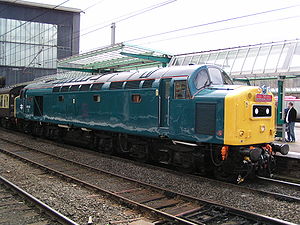British Rail Class 40

40145 on a charter train at Carlisle, 27 August 2004
|
|||||||||||||||||||||||||||||||||||||||||
|
|||||||||||||||||||||||||||||||||||||||||
|
|||||||||||||||||||||||||||||||||||||||||
|
|||||||||||||||||||||||||||||||||||||||||
|
|||||||||||||||||||||||||||||||||||||||||
| Type and origin | |
|---|---|
| Power type | Diesel-electric |
| Builder | English Electric at Vulcan Foundry and Robert Stephenson and Hawthorns |
| Build date | 1958–1962 |
| Total produced | 200 |
| Specifications | |
|---|---|
| Configuration: |
|
| • Whyte | 1Co-Co1 |
| • UIC | (1Co)'(Co1)' |
| Gauge | 4 ft 8 1⁄2 in (1,435 mm) standard gauge |
| Wheel diameter |
Driving: 3 ft 9 in (1.143 m) Idling: 3 ft 0 in (0.914 m) |
| Minimum curve | 4.5 chains (91 m) |
| Wheelbase | 61 ft 3 in (18.67 m) |
| Length | 69 ft 6 in (21.18 m) |
| Width | 9 ft 0 in (2.74 m) |
| Height | 12 ft 10 in (3.91 m) |
| Loco weight | 133 long tons (135 t; 149 short tons) |
| Fuel capacity | 710 imp gal (3,200 l; 850 US gal) |
| Prime mover | English Electric 16SVT MkII |
| Generator | DC generator |
| Traction motors | DC traction motors |
| Transmission | Diesel-electric transmission |
| MU working | ★ Blue Star |
| Train heating | Steam |
| Train brakes | Vacuum; later Dual (Air & Vacuum) |
| Performance figures | |
|---|---|
| Maximum speed | 90 mph (140 km/h) |
| Power output |
Engine: 2,000 bhp (1,490 kW) At rail: 1,550 hp (1,160 kW) |
| Tractive effort | Maximum: 52,000 lbf (231 kN) |
| Brakeforce | 51 long tons-force (508 kN) |
| Career | |
|---|---|
| Operators | British Railways |
| Numbers | D200–D399, later 40 001–40 199 |
| Nicknames | Whistler |
| Axle load class | Route availability 6 |
| Withdrawn | 1976-1985 |
| Disposition | seven preserved, remainder scrapped |
The British Rail Class 40 is a type of British railway diesel locomotive. Built by English Electric between 1958 and 1962, and eventually numbering 200, they were for a time the pride of the British Rail early diesel fleet. Despite their initial success, by the time the last examples were entering service they were already being replaced on some top-link duties by more powerful locomotives. As they were slowly relegated from express passenger uses, the type found work on secondary passenger and freight services where they worked for many years, the final locomotives being retired from regular service in 1985.
The origins of the Class 40 fleet lay in the prototype diesel locomotives (Types D16/1 ordered by the London, Midland and Scottish Railway and British Railways and D16/2 ordered by British Railways between 1947 and 1954) and most notably with the Southern Region locomotive No. 10203, which was powered by English Electric's 16SVT MkII engine developing 2,000 bhp (1,460 kW). The bogie design and power train of 10203 was used almost unchanged on the first ten production Class 40s.
British Railways originally ordered ten Class 40s, then known as "English Electric Type 4s", as evaluation prototypes. They were built at the Vulcan Foundry in Newton-le-Willows, Lancashire. The first locomotive, D200, was delivered to Stratford on 14 March 1958. Following fitter and crew training, D200 made its passenger début on an express train from London Liverpool Street to Norwich on 18 April 1958. Five of the prototypes, Nos. D200, D202-D205, were trialled on similar services on the former Great Eastern routes, whilst the remaining five, Nos. D201, D206-D209, worked on Great Northern services on the East Coast Main Line.
...
Wikipedia
